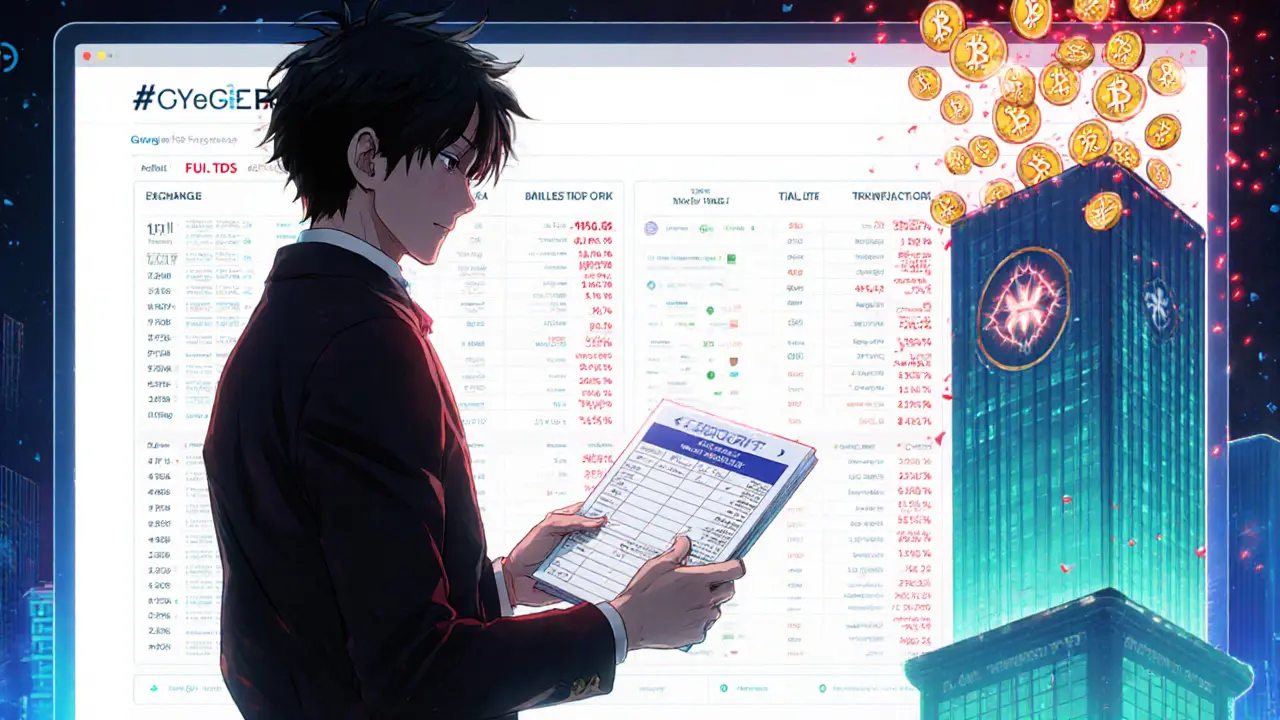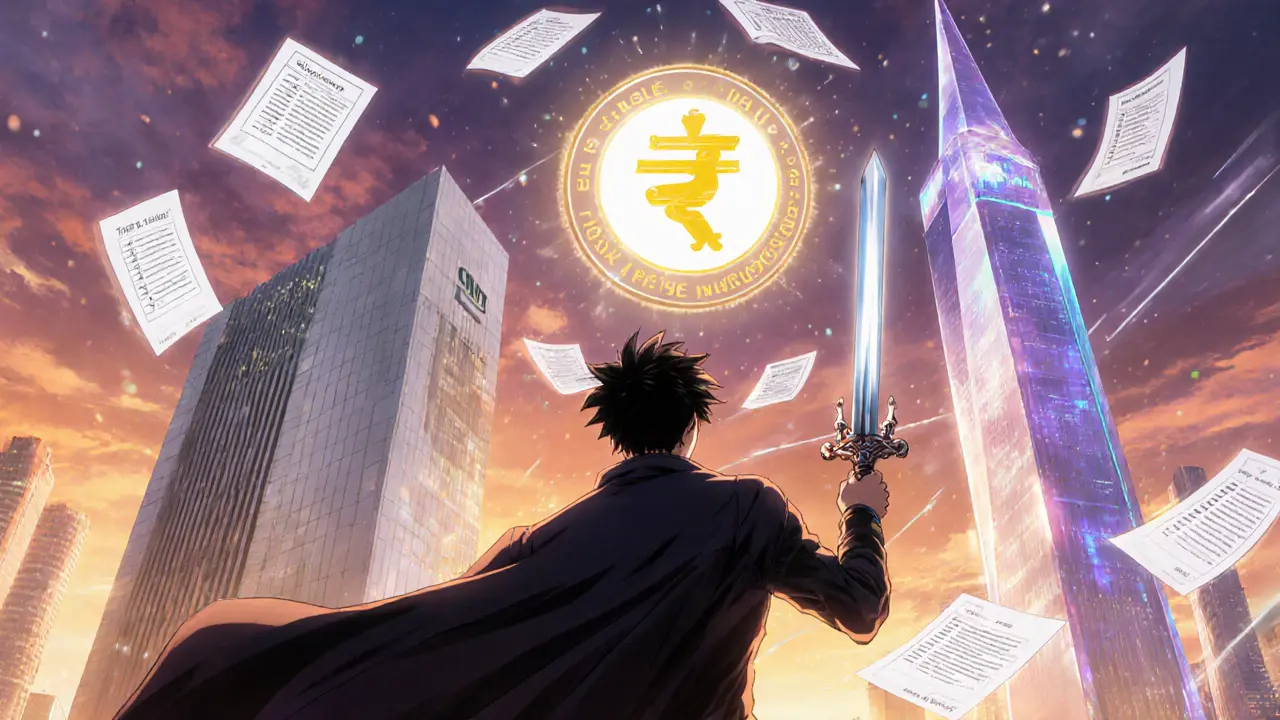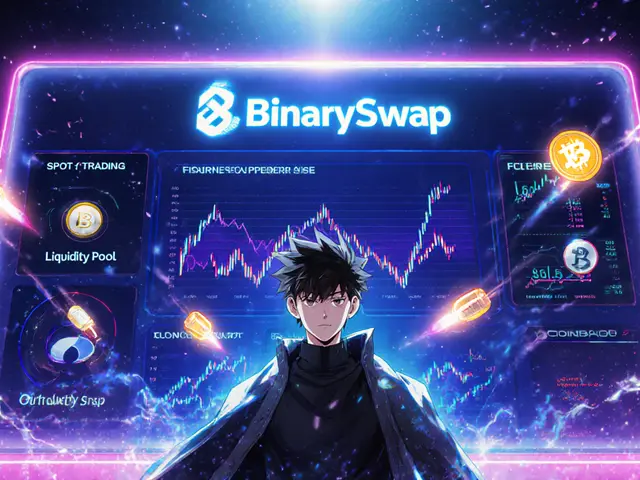Crypto Tax Calculator
Calculate Your Crypto Tax Liability
This calculator helps you determine your tax obligations for cryptocurrency transactions in India based on the current 30% tax rate plus 1% TDS.
Your Tax Breakdown
Transaction Value: ₹0.00
Taxable Gain: ₹0.00
30% Tax: ₹0.00
1% TDS: ₹0.00
Net Tax Due: ₹0.00
Every time you hear about Bitcoin or Ether making headlines, the first question from an Indian investor is: Can I legally use crypto here? The short answer is yes, you can buy, sell and hold digital assets, but they sit in a legal grey zone where the government taxes every transaction and watches them closely. This guide breaks down what that means in plain English, walks you through the current tax rules, shows which agencies are involved, and gives you a clear checklist so you don’t get caught off‑guard.
Quick Take
- Cryptocurrencies are classified as “Virtual Digital Assets” (VDAs) under Indian law.
- All gains are taxed at a flat 30%plus a 1% TDS on each transaction.
- The Reserve Bank of India, FIU‑IND, CBDT and SEBI all have overlapping oversight.
- Crypto is not legal tender and cannot be used for payments.
- Stay compliant by keeping detailed records and filing ScheduleVI‑A in your income‑tax return.
Cryptocurrency regulation in India refers to the evolving legal framework that governs buying, selling, holding and taxing digital assets such as Bitcoin, Ether and NFTs as of 2025. It has moved from outright bans to a structured tax regime, but the rules remain strict and the environment is still called a "legal grey area" by experts.
How the law defines crypto
In the 2024‑25 financial year the government introduced a definition called Virtual Digital Assets (VDAs) any code, token or piece of information created through cryptography, including cryptocurrencies, NFTs and similar digital tokens, but excluding fiat currencies.. This definition lives in Section2(47A) of the Income Tax Act, 1961 the primary legislation that governs taxation in India., which was later updated by the Income Tax (No.2) Bill, 2025.
The act makes clear two things:
- Holding or trading VDAs is legal; you just have to pay tax.
- VDAs cannot be used as legal tender - you can’t pay your electricity bill with Bitcoin.
What the tax regime looks like
The tax framework is simple on paper but heavy in practice. All income from VDA transfers is slapped with a flat 30% tax rate. There are no deductions, no set‑offs against losses, and the tax is applied whether you made a profit, a loss, or broke even.
On top of that, every crypto transaction triggers a mandatory 1% Tax Deducted at Source (TDS). The TDS is collected by the exchange or broker and deposited with the tax department, similar to the way salary tax is deducted at source.
For example, if you sell 0.5BTC for ₹5million, the exchange will withhold ₹50,000 as TDS. When you file your return, you’ll still owe 30% of the ₹5million gain, but you can claim the ₹50,000 TDS as a pre‑payment.
Compliance steps:
- Maintain a spreadsheet with date, asset, amount, INR value, and TDS amount for each transaction.
- Report total VDA income in ScheduleVI‑A of your I‑TR.
- Attach Form26AS to show the TDS credits collected by exchanges.

Who watches the crypto market?
Regulation isn’t handled by a single agency. Instead, several bodies coordinate:
- Reserve Bank of India (RBI) the central bank that issues public cautions on crypto risk and is developing a sovereign digital rupee.
- Financial Intelligence Unit‑India (FIU‑IND) the agency that enforces anti‑money‑laundering standards on crypto exchanges.
- Central Board of Direct Taxes (CBDT) the tax authority that designs the VDA tax rules and monitors compliance.
- Securities and Exchange Board of India (SEBI) the securities regulator that is debating whether to grant a broader licensing framework for crypto trading platforms.
Each agency publishes its own guidance, and they often issue joint circulars. If you’re a trader, the most practical advice is to follow the RBI’s risk warnings, the FIU‑IND’s KYC/AML rules, and the CBDT’s tax filing requirements.
Key milestones - how we got here
| Year | Event | Impact |
|---|---|---|
| 2013 | RBI first public caution | Warned of financial and security risks |
| 2018 | Banking ban on crypto services | Blocked bank accounts for exchanges |
| 2020 | Supreme Court strikes down ban | Opened the market for exchanges again |
| 2022 | Tax notice rollout | Authorities started probing undeclared crypto income |
| 2024 | VDA definition added to Income Tax Act | Formal legal recognition of crypto as taxable asset |
| 2025 | Income Tax (No.2) Bill receives assent | Flat 30% tax + 1% TDS becomes law |
Notice how the Supreme Court decision in 2020 was the turning point. Before that, banks refused to work with crypto firms, making it almost impossible to convert digital assets to rupees. After the judgment, exchanges resurfaced, but the tax and AML machinery followed closely.
Checklist for Indian crypto users
- Verify that your exchange is registered with the FIU‑IND and follows RBI KYC norms.
- Enable two‑factor authentication and keep backup of private keys offline.
- Record every transaction - date, asset, amount, INR value, TDS deducted.
- Report total VDA gains in ScheduleVI‑A when filing your I‑TR.
- Keep Form26AS handy to prove TDS credits.
- Stay updated on any new RBI circulars or SEBI proposals - they can change reporting requirements.
Missing any of these steps can trigger a notice from the tax department, which often results in penalties and interest on unpaid tax.
What the future might hold
India is still drafting a comprehensive crypto bill. The Ministry of Finance has hinted at a framework that could separate “utility tokens” from “security tokens” and possibly create a licensing regime for exchanges. Meanwhile, the RBI continues to develop its own Central Bank Digital Currency (CBDC) - the e‑Rupee - which could coexist with private VDAs but with stricter controls.
Internationally, India pushed for a unified G20 approach at the 2023 summit, supporting the Crypto‑Asset Reporting Framework (CARF). That means Indian authorities will likely tighten cross‑border reporting, making it harder to hide crypto income abroad.
Bottom line: expect more clarity, not less regulation. Keep your records tidy, use compliant platforms, and treat crypto earnings like any other taxable investment.

Frequently Asked Questions
Is it illegal to own Bitcoin in India?
No. Owning Bitcoin or any other VDA is legal, but you must pay tax on any gains and cannot use it as legal tender for everyday purchases.
Do I have to pay tax if I just hold crypto and don’t sell?
Tax is triggered only by a transfer that results in a gain or loss. Simply holding a VDA in a wallet does not create a taxable event, but you must still disclose any income earned from staking or interest.
What is the 1% TDS and who collects it?
Every crypto trade on a registered exchange has 1% of the transaction value withheld at source. The exchange deducts it and deposits it with the Income Tax Department, similar to salary tax.
Can I use crypto to pay for goods or services?
No. The RBI has made it clear that cryptocurrencies are not recognized as legal tender, so merchants cannot accept them as payment under Indian law.
What records should I keep for tax filing?
For each transaction record the date, asset type, quantity, INR value at the time of trade, and any TDS deducted. Keep these in a spreadsheet or accounting software and retain them for at least five years.









Comments (19)
katie littlewood
October 22, 2024 AT 22:26 PMIndia's crypto landscape is finally stepping out of the shadows, and that's a cause for celebration across the subcontinent! The 2023 Finance Act gave us a glimpse, but the 2025 regulatory roadmap really tightens the screws in a surprisingly friendly way. First, the Financial Intelligence Unit has mandated reporting thresholds that are both realistic and enforceable, meaning everyday traders can stay compliant without breaking a sweat. Second, the Reserve Bank of India has clarified that stablecoins can be used for payments, provided they adhere to the newly instituted capital adequacy norms. Third, the Supreme Court's recent judgment on digital assets has set a precedent that treats cryptocurrencies as property, opening doors for broader financial inclusion. Moreover, the tax framework now distinguishes between short‑term and long‑term holdings, aligning crypto gains with the existing capital gains regime, which simplifies filing for most users. The introduction of a 1% TDS on crypto transactions is a modest step towards transparency, yet it also ensures that the tax net captures revenue without stifling innovation. On the flip side, the enforcement agencies have been given sweeping powers to investigate suspicious transfers, which is a double‑edged sword for privacy‑conscious participants. However, the community can rest easy knowing that the guidelines also emphasize robust KYC protocols, safeguarding both investors and the broader financial system. In practice, this means that a modest crypto trader in Bangalore can now use a compliant exchange, file taxes using the familiar Schedule VI‑A, and stay on the right side of the law without needing a PhD in tax code. The government’s push for blockchain adoption in sectors like supply chain and agriculture further underscores its commitment to nurturing the ecosystem. While some critics argue that the tax rate of 30% plus 1% TDS is steep, the reality is that it mirrors the rates for other high‑value assets, fostering a level playing field. Additionally, the upcoming "Crypto Safe Harbor" scheme promises to offer tax incentives for startups focused on decentralized finance, which could spur a new wave of innovation. For the average enthusiast, the key takeaway is simple: stay informed, keep records of every transaction, and leverage the new calculator tool to gauge your liability. In the end, a well‑regulated environment is the catalyst that transforms speculative excitement into sustainable growth. So gear up, folks, because 2025 might just be the year crypto finds its true home in India!
Jenae Lawler
October 22, 2024 AT 22:29 PMWhile many proclaim newfound clarity, the reality remains an intricate labyrinth of legislative ambiguity.
Chad Fraser
October 22, 2024 AT 22:32 PMHey folks, great to see this breakdown! The Indian government’s push to formalize crypto taxation is actually a win for newcomers who were scared off by the gray area. By laying out a clear 30% tax plus 1% TDS, they give us a roadmap to stay legit without constantly fearing raids. Plus, the reporting thresholds are realistic – you don’t need a massive ledger to stay compliant. It’s also encouraging that the RBI is slowly warming up to stablecoins for payments, which could boost everyday use cases. Bottom line: keep your records tidy, use the calculator, and you’ll be fine. Keep the momentum going!
Jayne McCann
October 22, 2024 AT 22:36 PMHonestly, I think the new rules are just another way for the government to tax us more. They’ll probably tighten them again next year.
Parker Dixon
October 22, 2024 AT 22:39 PM👍 Absolutely love that there’s now a concrete calculator to help us figure out the tax hit. It’s super helpful to see the breakdown: transaction value, taxable gain, 30% tax, and the 1% TDS all laid out clearly. For anyone juggling multiple trades, just plug the numbers in and you’ll avoid nasty surprises at filing time. 🌟 Remember to keep your transaction receipts – the tax office loves paperwork! And if you’re unsure about classifying a VDA, the “Other VDA” option is a safe fallback. Happy trading, and stay compliant! 😊
Stefano Benny
October 22, 2024 AT 22:42 PMFrom a compliance engineering standpoint, the RBI's MRA alignment introduces a de‑facto KYC/AML layer that effectively functions as a deterministic state machine for transaction validation. The 30% marginal tax rate, when modeled as a piecewise linear function, interacts with the 1% TDS as a fixed‑rate sink, reducing net liquidity flow. Moreover, the integration of Schedule VI‑A into the e‑filing API creates a seamless ETL pipeline for crypto‑derived income. In short, the regulatory schema is both robust and extensible, supporting future tokenomics iterations.
Bobby Ferew
October 22, 2024 AT 22:46 PMSure, the calculator looks neat, but honestly most people just skim it and hope for the best. The tax code is still a maze, and the VDA classification can feel like a vague buzzword soup. Anyway, keep using it if it makes you feel better.
celester Johnson
October 22, 2024 AT 22:49 PMIn the grand tapestry of finance, cryptocurrency represents a digital echo of humanity's perpetual quest for autonomy. Yet, the moment a sovereign imposes tax, it transforms that echo into a measured cadence, bound by law. Regulation, therefore, is not merely a restriction but an articulation of societal values, a dialogue between individual liberty and collective responsibility. When India codifies crypto, it whispers a promise that even the most ethereal assets must answer to the communal ledger. This synthesis, paradoxical as it seems, may usher in a new epoch where decentralization and governance coexist, each tempering the other.
Prince Chaudhary
October 22, 2024 AT 22:52 PMWell said. The balance you describe is exactly what we need – clear rules that still allow innovation to flourish without stifling creativity.
John Kinh
October 22, 2024 AT 22:56 PMMeh, another tax thing. They’ll probably change it again next year.
Mark Camden
October 22, 2024 AT 22:59 PMIt is incumbent upon every taxpayer to honor the civic duty of full disclosure, especially when dealing with assets as volatile as cryptocurrencies. Ignoring the obligations set forth by the Finance Act not only undermines the legal framework but also erodes public trust in our institutions. In my view, the ethical course is to adopt the calculator, file accurately, and contribute to the nation's fiscal health.
Evie View
October 22, 2024 AT 23:02 PMStop pretending this is optional – you either comply or you face the consequences.
Sidharth Praveen
October 22, 2024 AT 23:06 PMExactly, compliance isn’t a choice; it’s the foundation for a sustainable market that benefits everyone.
Nathan Blades
October 22, 2024 AT 23:09 PMPicture this: a bustling Indian market where vendors accept crypto alongside rupees, all under the watchful eye of a transparent tax system. That vision isn’t far‑off if we embrace the 2025 guidelines. By integrating the calculator into daily trading routines, we demystify the tax burden and empower traders to focus on strategy rather than paperwork. The 30% rate aligns with other capital assets, making crypto a legitimate component of diversified portfolios. Moreover, the 1% TDS acts as a modest safety net, ensuring the treasury captures revenue without crushing growth. In this scenario, the Indian blockchain ecosystem can thrive, attracting global investors and fostering homegrown innovation. It’s a narrative worth championing, and we all have a role to play in writing it.
Debby Haime
October 22, 2024 AT 23:12 PMTotally agree – the narrative becomes real when each of us does the simple step of logging our trades and using the calculator. It’s the little habits that build the bigger picture.
Andy Cox
October 22, 2024 AT 23:16 PMnice read, i guess the tax thing is finally getting sorted out.
Courtney Winq-Microblading
October 22, 2024 AT 23:19 PMIndeed, the simplicity of the new framework feels like a breath of fresh air amidst the usual bureaucratic fog. By demystifying the process, it invites even the most hesitant participants to dip their toes into the crypto waters.
Richard Herman
October 22, 2024 AT 23:22 PMFrom a global perspective, India’s move could set a benchmark for emerging markets seeking to harmonize crypto innovation with fiscal responsibility.
Sophie Sturdevant
October 22, 2024 AT 23:26 PMBy standardizing VDA reporting protocols and embedding the tax computation within the API layer, regulators create a scalable compliance architecture that can adapt to future token classifications.